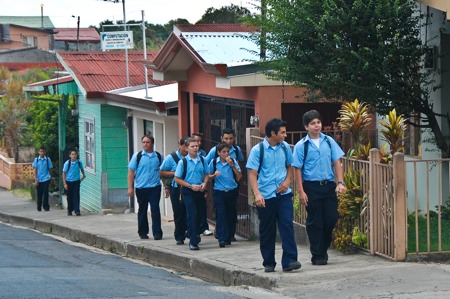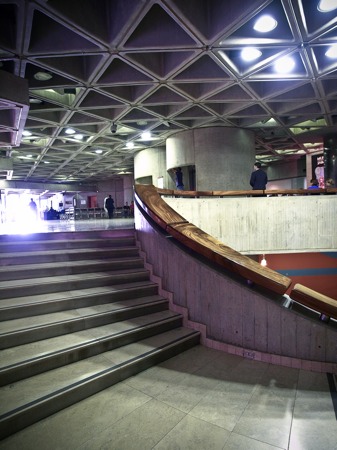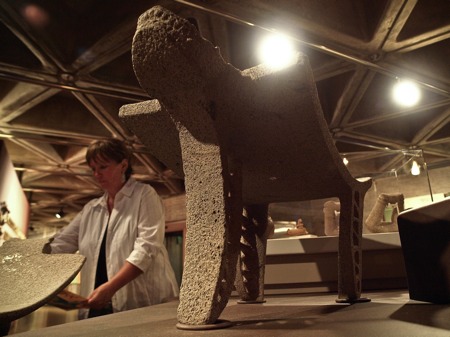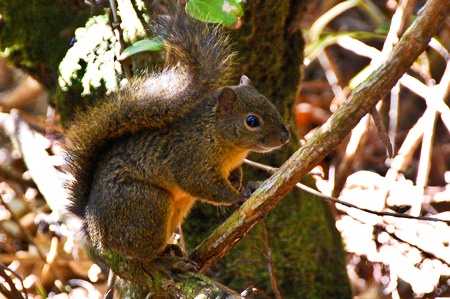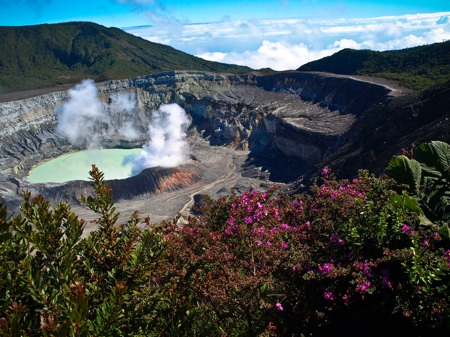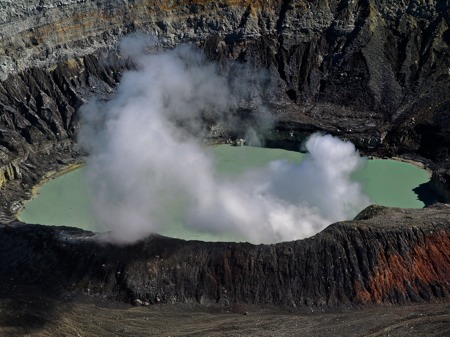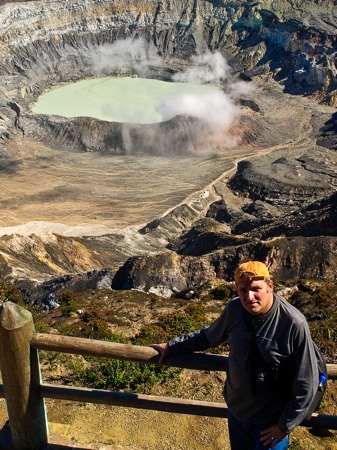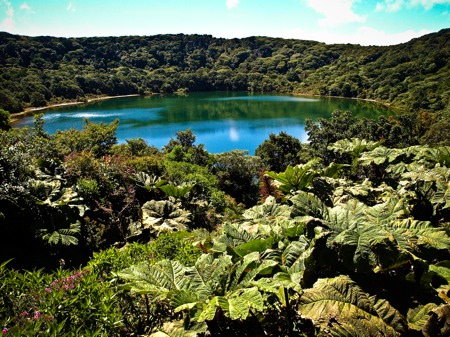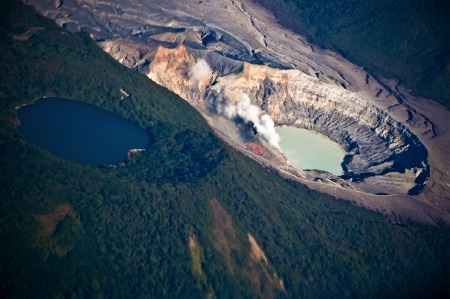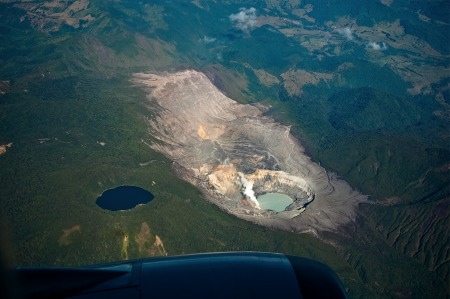by Anne Watcher on Thursday March 6th, 2008 at 4:35pm
Costa Rica is very proud of it's education system and stresses education very strongly. After being here only for a short time you can't help but notice the children on their way to school, mainly because uniforms are mandatory for all public schools. There seems to be different uniforms for different ages from powder blue shirts and navy pants to sage green golf shirts and black pants. They really do look nice when you see them walking down the streets, laughing and talking as kids should.
We've also noticed that their day starts early, usually at 7:00 am and goes to anywhere between 1:00 and 4:00. Many of the students use the public buses for getting home as Rob and I witnessed when we got on the bus to Turrucares at the stop by the local elementary school. What a packed bus that was and the energy level was high and loud, typical of most children that age.
Having our closest bus stop by the school here in La Garita we have had time to observe school activities. Physical fitnesses seems to be a big part of the learning process and we have seen children of all ages doing relay races, playing tag, dodge ball and of course the national past-time, soccer. Even after hours it is quite common to see boys out in the soccer field practicing and possibly dreaming of the big leagues. We have been told that english and computer skills are mandatory in the public system as is attendance.
The children here in Costa Rica by and large are friendly, helpful and polite. Quick to say "hola" when they meet you on the street, they don't seem to let any language barrier stop them from trying to communicate with you. It is amazing how a smile, some hand gestures, their bit of english and our bit of spanish can keep a conversation going!!
by Anne Watcher on Thursday March 6th, 2008 at 6:10am
If you like history or culture a trip to the Museo del Oro - Gold Musuem in San Jose is a perfect way to experience both. It is located below the Plaza de la Cultura - Cultural Plaza at Avenida Central and Calle Treis - Central Avenue and Third Street. The National Theater is next door and definitely is worth viewing. Our walk down from the bus terminal was interesting and fun. Avenida Central is closed to traffic through much of this area and it beams with people shopping, street vendors, flower markets and some very interesting buildings.
Upon entering the museum entrance I noticed the beautiful architecture. It is quite amazing with it's large circular stairway lined with a wood slab handrail polished to a glimmering shine. The floors throughout are all made of wood, different varieties put together like parquet.
The many displays show artifacts back as far as 500 BC and up to 1600 AD. The displays are well lit making viewing easy and all have very detailed descriptions both in Spanish and English. It really was a glimpse back in time and an education of the indigenous groups that lived in Costa Rica.
Also included in the entrance with a small display of the history of the money in Costa Rica and some of it's battles to remain a separate country. Interesting I thought considering now that it doesn't even have a military, banning it in 1949. The use of "coffee tokens" instead of money also was a historical tidbit I enjoyed. When official money became scarce, workers were paid with them and could use them at the plantation stores or businesses associated with it. Quite often the value related to the number of baskets of coffee picked by the worker.
Entrance Fee: c3500 - $7.00 for non-resident
Sweeping spiral staircase connects the floors of the museum
Grinding Tables from between 500 BC to 500 AD
Book of Historical Facts
Gold Disks and Necklaces often denoted class or position of person in the tribe
Some are intricate in design, some quite simple
Small, very detailed gold artifacts depicting animals and birds
A Costa Rican Warrior
Overview of part of museum display area, notice the floor and ceiling
by Anne Watcher on Tuesday March 4th, 2008 at 9:17pm
I'm not sure what it is about me and squirrels on this trip but we were able to photograph this little fellow while at Poas. It is the aptly named the Poas Squirrel and only inhabits three volcanic mountaintops in the world. Fortunately for us one is Volcan Poas, the others being one in Panama and the other being Tapanti National Park also in Costa Rica.
As we continued on the trail after viewing Lake Botos (the highest elevation of the park) we found these little fellows scurrying around on the dense jungle underbrush. This one stopped long enough for Rob to take his picture, he almost seemed to pose. These "mountain squirrels" are identifiable by their greenish-yellow colour with a tail always as least as long as their body. Also notice the small short ears which set them apart from the similar but more populous red squirrel.
Poas Squirrel
by Anne Watcher on Tuesday March 4th, 2008 at 9:14pm
Picking the right day to visit this unique volcano is really the biggest challenge and we picked the perfect day. Being one of the "cloud forests" in Costa Rica, the crater is quite often covered over with dense mist and fog. But it was clear, sunny and warm when Rob and I visited. We made sure we were there (second car) when the park opened at 8:00 am which meant leaving Norma's at 7:00 am. Others there had commented how this was their third or fourth attempt at seeing the sight without cloud. Some said they had seen only glimpses as the clouds moved on and off.
As we walked up to the crater's edge it really was the most awe inspiring sight we have ever seen. The intensity of colours, smells and textures were amazing.
Poas is not the highest or the most active of Costa Rica's volcanoes but it is the only one with two craters-one active and one filled with a cold water lake surrounded by a dense jungle. The main crater holds the only place where a lake of liquid sulfur can be found and boiling sulphurous gases spew regularly from the steam vents surrounding the crater. Poas also allows the viewer to get right up to the crater, driving up to 600m. from the rim and walking up to the edge. The main crater is found at an elevation of 2708 m., measures 1.5 km across with the inner crater lagoon measuring 400 m. in diameter. Occasionally the emissions of sulphur gas reaches amounts that closes the park for a short time. Obviously the day we were there the levels weren't that high but when a gust of wind blew by the distinctive ordour made you aware of it's presence.
Vegetation surrounding Poas has been stunted or totally destroyed in places but you can see shades of green on the lava flows where plant life once again is springing forth. Walking through the dwarf forest to the crater holding Lake Botos is a fascinating experience. It is dense and jungle like, moss growing and covering everything. Tough ferns and bonsai type trees are kept stunted due to the acid rain. The air is noticeably cool but not too far overhead you can see the sun as most of the trees are no more than 20'. Tropical plants and flowers cover the forest floor and animal life can be heard but hard to see. Coming into the clearing at the end of the trail reveals beautiful Lake Botos, emerald green in colour and quite surreal. Pictures really do not do sights like this justice!!
Poas National Park is home to over 75 species of birds including hummingbirds and the Quetzal. Small mammals like the coyote and skunk also call this home. Nature lovers of all ages and abilities can enjoy the well maintained trails of "Parque Nacional Volcan Poas"!!
We choose to hire a taxi and the driver stayed with us for the six hour complete trip (3 at the park). Costs to get into the park were c11800 ($24.00 approx.) for two non-resident tickets, one resident (our driver) and one parking space. Taxi cost c30000 ($60.00)
Main Crater - sulfuric steam rising from the vents - notice that we are higher than the clouds!
Liquid Sulfur Lake
Life returns to where lava once flowed
Small bonsai-like trees on the one side of the crater
Notice how close you get to the crater edge!
Dense Dwarf Forest
Beautiful Lake Botos
View of Poas and Lake Botos from the air
Hard to imagine that those 2 craters are at the top of a 9200 foot mountain - - -
when viewing this photograph that includes more of the surrounding terrain.
by Anne Watcher on Tuesday March 4th, 2008 at 9:12pm
If you are ever caught in the rain in Central America just look for a "Poor Man's Umbrella" plant to get protection. A close relative of the Giant Rhubarb, it is native to this area and grows quite prolifically here in the mountainous tropic and subtopic weather. It definitely prefers environments with cloudy, shaded light.
The Poor Man's Umbrella (or Parasol) grows to 4-6 feet across, hence it's name. The seeds are poisonous and all parts of the plant cause skin irritations so if you want to plant one at home, pick a shaded moist area, don't feed anybody the seeds or ask them to rub up against it. I guess that makes gloves mandatory when using it for an umbrella!!
I used Rob to show the scale of the size of these plants
